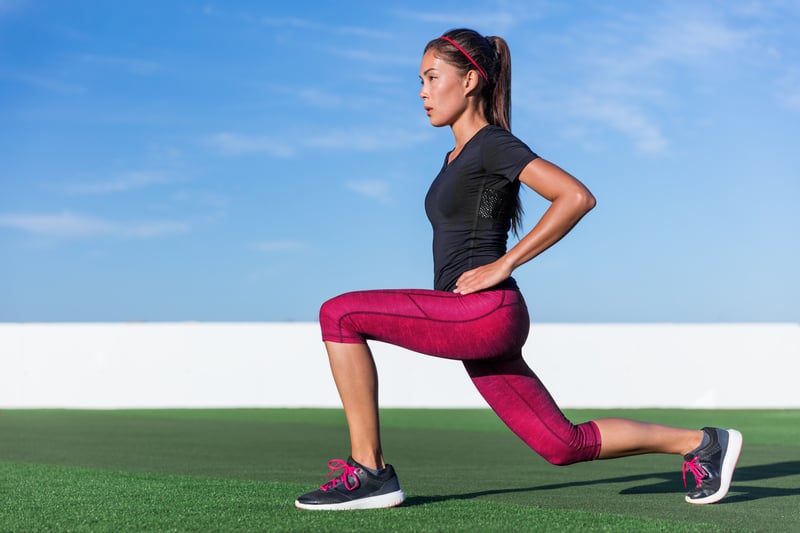Dynamic Stretching: What Is It + 7 Stretches to Get Started

You know you should stretch, and you’re ready to get started, but what are the different kinds of stretching, and what on earth is dynamic stretching?
Different Types of Stretching
Let’s begin with stretching in general. There are two basic types of stretching: static and dynamic. Static stretching does not involve movement. You stretch the muscle and hold it. Dynamic stretching does involve movement. With dynamic stretching, you bring the muscles and joints through a full range of motion.
Static and dynamic stretches are further broken into seven categories:
1. Ballistic stretching—this type of stretching involves pushing your muscles further than they normally stretch on their own and typically uses a bouncing kind of movement to stretch your body past the usual point of stopping. This is generally considered unsafe and should be avoided.
2. Dynamic stretching—this mode of stretching involves momentum and moves the muscles and joints through a full range of motion, similar to what they will experience when engaged in a sport.
3. Active stretching—static-active stretching involves recruiting opposing muscles to help with a stretch. Yoga is an example of active stretching where you hold a pose. The muscles required to hold the pose are stretched while the targeted muscle is able to relax.
4. Passive stretching—static-relaxed stretching is stretching assisted by another body part. For example, you might place your heel on a bench and lean over to stretch your hamstrings.
5. Static stretching—these stretches do not involve movement and instead are simply held for 30 – 45 seconds at a time.
6. Isometric stretching—this involves first getting into a passive stretch, then tensing the muscle for about ten seconds and then releasing to allow the muscle to relax.
7. PNF (proprioceptive neuromuscular facilitation) stretching—this is a combination of passive and isometric stretching. It involves holding, contracting, stretching, and bouncing and should only be done with experienced supervision. It is sometimes used in rehab situations and is best done with a partner.
A Deeper Dive into Dynamic Stretching
Dynamic stretching prepares your body for movement. By moving your limbs, muscles, and joints through a full range of motion, you are effectively warming up your body. Often, people will warm up with a movement similar to what they will be doing in the exercise or sport they are warming up for. For example, runners may do leg swings (or pendulum swings) both front and back and side to side to open up the hip and leg muscles as they warm up.
The Benefits of Dynamic Stretching
1. Less likely to get injured. Because dynamic stretching often mimics the movements you’ll likely do in the sport you will be playing, it serves as a fantastic way to warm up the muscles and joints and put them through the full ranges of motion they will use.
2. More mobility. Warming up in a dynamic manner like this allows you to become more mobile, not only in the mobility exercises but in your chosen activity as well.
3. More flexibility. Yes, dynamic stretches also help you become more flexible just like the other forms of stretching do. With regular practice, your muscles will become more limber, and you’ll notice a greater range of motion when moving through the stretches.
4. Functional stretching. This type of stretching also prepares you for the activity you are about to do. Because you’re moving your muscles and joints through the same type of motion involved in your sport or activity, it serves as the perfect warm-up, allowing you to fully warm up your muscles and prepare them for action.
Try These Dynamic Stretches for Yourself
These dynamic stretches can complement your workout. Try choosing a few relevant stretches and do 10 – 15 repetitions of each.
1. Walking Lunges

Stand with your feet together and your hands on your hips. Take a giant step forward with your right foot, bending the right knee until your thigh is about parallel with the floor. Keep your head up and your torso upright as you push through your left foot to propel your body back up to standing. Bring your feet back together and repeat on the opposite side. That completes one repetition.
2. Body Squats

Start with your feet about hip-width apart. Place your hands on your hips or clasp your hands in front of you. Push your hips back as you bend your knees, keeping your upper body relatively upright throughout the movement. Once your thighs are parallel with the ground, push back up to standing.
3. Arm Circles

Begin by standing with your feet slightly apart for balance. With your arms shoulder level and held straight out to your sides, start by making small forward circles with your arms. Gradually increase the size of the circles as you complete revolutions. Do ten circles in the forward position and then switch directions, completing ten circles in the opposite direction.
4. Leg Pendulums
Begin by standing with your feet together and your hands on your hips or grab a chair or countertop for balance. Lift your right leg off the ground and swing it forward and backward, gradually increasing the distance of your swing. You can also do a side-to-side leg swing with the same pendulum motion.
5. High Knee to Chest Walk

Stand with your feet together. Lift your right leg, bending at the knee and bringing it up to your chest as you step forward. Place your right leg on the ground as you repeat on the left. You can either use a forward walking motion for this exercise or do it in place.
6. Spinal Rotations
Stand with your feet about hip-width apart and bring your arms up and straight out to your sides. Slowly turn all the way to the right by twisting your torso. Return to center and then repeat on the opposite side.
7. Plank Walk Out
Start by standing with your feet together. Bend at the hips, keeping your legs straight, and place your palms on the ground in front of you. Walk your hands out until you are in a full plank position. Reverse the movement to walk yourself back up to standing.




 7 Signs Your Body is Seriously Low on Collagen (not just wrinkles)
7 Signs Your Body is Seriously Low on Collagen (not just wrinkles) Health Expert: "Turmeric Doesn't Work (unless...)"
Health Expert: "Turmeric Doesn't Work (unless...)" 3 Warning Signs Your Probiotic Supplement is a Total Waste
3 Warning Signs Your Probiotic Supplement is a Total Waste

